Fences are permitted subject to the following:
(a) Application, Review, Permits and Fees. No person shall cause, build or relocate a fence within the City without first having obtained a permit therefor from the Building Official. Decorative and temporary fences are to be reviewed by the Building Official; however, these types of fences do not require a fence permit.
Applications for fence permits shall be made upon forms provided by the Building Official and shall contain or have attached thereto the following information:
(1) Name, address and telephone number of the property owner.
(2) Location of the building, structure or lot to which or upon which the fence is to be attached or erected.
(3) Location of the fence in relation to nearby buildings, structures and lot lines.
(4) Description of the type of fence to be constructed.
(5) Name of person, firm, corporation, or association erecting the fence.
(6) Any other information as requested by the Building Official in order to assure that full compliance with this section has been obtained.
(b) Permit Review and Revocation. It shall be the duty of the Building Official, upon the filing of an application for permit, to examine any plans and specifications and other related data and the premises upon which it is proposed to erect the fence, and if it shall appear that the proposed fence is in compliance with all the requirements of this section and all other laws and ordinances of the City, a fence permit shall then be issued. If the work authorized under a fence permit has not been started within six (6) months and or completed within one (1) year after the date of issuance, the said permit shall become null and void.
A fee for the fence permit required by this section shall be as set forth in the Schedule of Fees, as adopted by the City Council.
(c) Residential Districts - Fences. Fences may be built on all lots of record in all Residential Districts. Fences in the side and rear yards shall not exceed six (6) feet in height, measured from grade. The fence height may be increased an additional six (6) inches for the purpose of providing an open space at the base of the fence for property maintenance.
Fences in the front yard shall not exceed three and one-half (3-1/2) feet in height measured from grade, and shall not be placed within two feet of the property line. The vertical surface in any five (5) foot long section, measured from the finished ground grade to the top of the fence, shall have openings of at least 50% of the total fence surface. No solid or obscuring fence shall be located within the front yard area. All framing members, including post, horizontal or vertical supports, and fencing, must be considered in the calculation. Decorative fences does not include chain link fences. A solid or obscuring fence located within a side yard area fronting along a city street shall maintain a twelve (12) foot setback from the property line.
Where a fence is constructed on a residential lot abutting public, commercial or industrial alleys or properties, public play fields, parking lots, school grounds, or recreational areas, approved fences not exceeding six (6) feet in height may be erected and maintained alongside of rear lot lines abutting such alleys or properties.
Fences which enclose public or institutional parks, playgrounds, or public landscaped areas, situated within an area developed with recorded lots, shall not exceed six (6) feet in height, measured from the surface of the ground, and shall not obstruct vision to an extent greater than twenty-five (25) percent of the total area, unless said fence is constructed as a buffer from adjoining residential properties.
(d) Nonresidential Districts - Fences. Fences built in Office and Commercial Districts shall not exceed six (6) feet in height, measured from grade. Fences built in industrial districts shall not exceed eight (8) feet in height, measured from grade. The fence height for all nonresidential districts may be increased an additional six (6) inches for the purpose of providing an open space at the base of the fence for property maintenance.
Fences not used as a buffer from adjoining residential property shall not obstruct vision to an extent greater than twenty-five (25) percent of its total area.
(e) For the protection of the general public, no swimming pool shall be constructed or maintained unless such swimming pool is entirely enclosed by a building and/or fence. The fence shall be designed and constructed so as to make the pool inaccessible to children by climbing or entering through any fence openings. The minimum height of all parts of a fence, including gates, shall be four (4) feet in height and not be more than six (6) feet in height measured from grade, for all pools. Swimming pools shall maintain a distance of not less than five (5) feet from any enclosing fence or other structure.
All gates shall be of a self-closing and latching type, with the latch on the inside of the gate not readily accessible for children to open. Gates shall be capable of being securely locked when the pool is not in use for extended periods.
(f) Temporary Construction Fences. Every excavation or area of construction on a site located five (5) feet or less from a property line shall be enclosed with a temporary fence or barrier to prevent the entry of unauthorized persons. Where located more than five (5) feet from a property line, a temporary fence or barrier shall be erected where required by the Building Department. Temporary fences must be removed within seven (7) days upon completion of any construction.
(g) General Requirements for all Fences. No fence shall be installed, erected or maintained except as provided in this section and in strict compliance with the following requirements:
(1) All fences herein shall be constructed solely of structurally sound materials and they shall be treated in a manner to maintain the fence in good structural condition and with an appearance that is aesthetically compatible with the type of fence it represents.
(2) The height of all fences shall be regulated by subsections (c) and (d) of this section.
(3) Any approved type of fence located in a front yard area shall maintain a two (2) foot minimum setback from a property line. Any approved type fence located along a side property line adjoining a city street shall comply with the following:
A. Any approved type fence shall maintain a two (2) foot minium setback from a property line.
B. A solid or obscuring fence shall maintain a twelve (12) foot minimum setback from a property line.
C. Where a solid or obscuring fence is located adjacent to an adjoining driveway a clear vision area may be required by the Building Official.
(4) Fences shall be constructed with suitable posts sunk into the ground at least three feet or installed according to the fence manufactures recommendations.
(5) Fences shall be constructed within all property lines, except where a written agreement is submitted to the City that allows for a duel ownership of a fence so located on a common property line. Visual corner stakes must be present. Where in the opinion of the Building Official may request a property survey at the expense of the property owner.
(6) The attaching of one fence to the face of another to form a single fence or barrier is expressly prohibited.
(7) All fences shall be constructed in such a manner that all structural members, including braces, posts, poles and other projections, shall be on the interior side of the fence.
(8) No wire or other fence materials shall be affixed to the fence with the top edge having any sharp or pointed projections of any kind, except where required by law for security reasons.
(9) No person shall use rope; string; wire products including but not limited to chicken wire, hog wire, wire fabric, and similar welded or woven wire fabrics; chain ; netting; cut or broken glass; paper; unapproved corrugated metal panels; galvanized sheet metal; plywood; or fiberglass panels in any fence or any other materials that are not manufactured specifically as fencing materials. The Building Official may require the applicant to provide the manufacturer’s standards to establish the intended use of a proposed fencing material.
(10) No barbed wire or razor wire shall be allowed, except where required by law.
(11) Fences shall not contain electric current or charge of electricity. This provision shall not apply to electrical barriers, provided below grade, used to contain household pets.
(12) In no instance shall the installation of a fence cause the isolation of property that is inaccessible for purposes of yard maintenance and upkeep. The Building Department may cause, under authority of this section the separation between fences, or a fence and a structure, or such other remedy, to ensure adequate access for cutting of grass and weeds and/or the collection of litter and debris.
(h) Fence Maintenance. Fences must be maintained in a neat and safe condition, so as not to endanger life or property. Any fence which, through lack of repair, type of construction or otherwise, endangers life or property is hereby deemed a nuisance. The Building Department shall notify the owner, agent or person in control of the property on which such fence is located of the existence of such nuisance and specify the required repairs or modifications to be made to render the fence safe or require that the unsafe fence or any portion thereof be removed and shall provide a time limiting such repair, modification, or removal.
Examples of fences allowed within the front yard area include rail and picket fences. Decorative fences like wrought iron fences are also allowed in the front yard area.
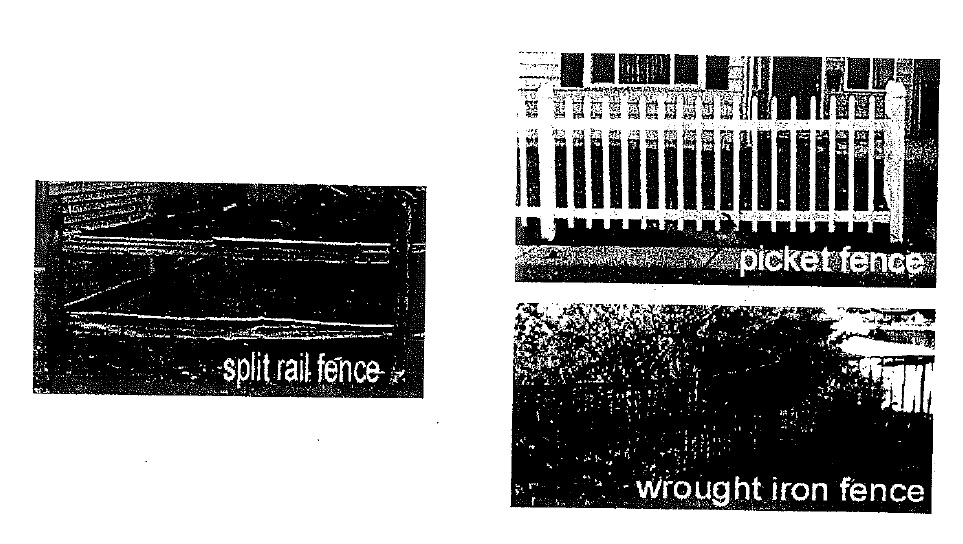
Examples of fences not allowed within the front yard area of all zoning districts except for nonresidential districts include chain link fences, wire fences, snow fences and stockade/board fences.
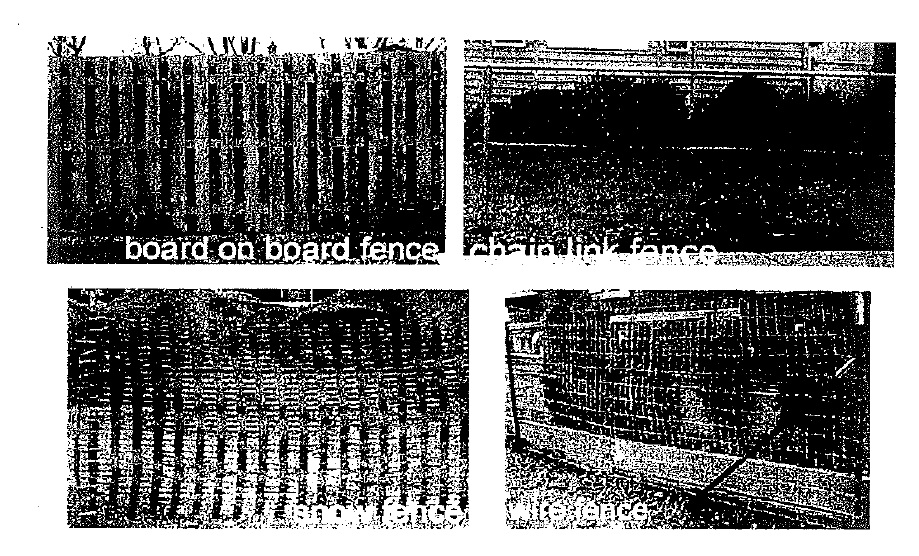
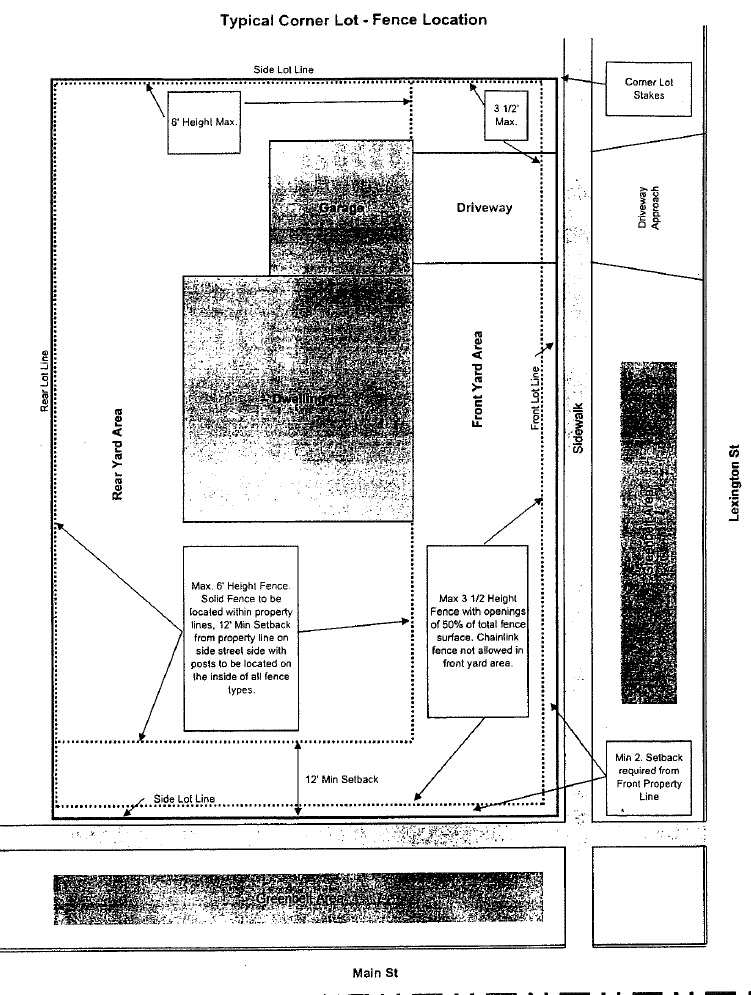
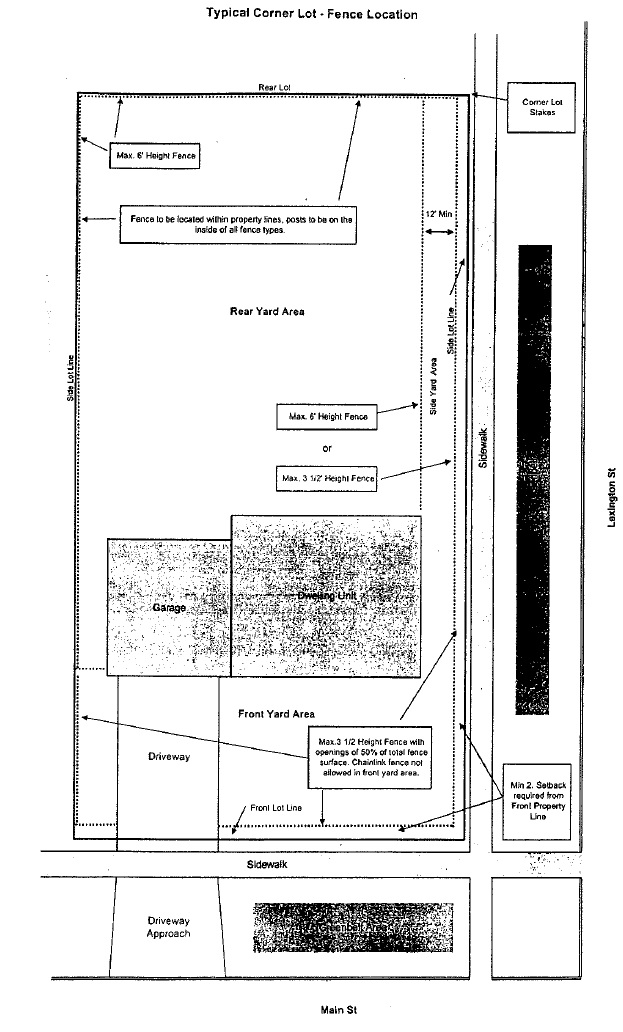
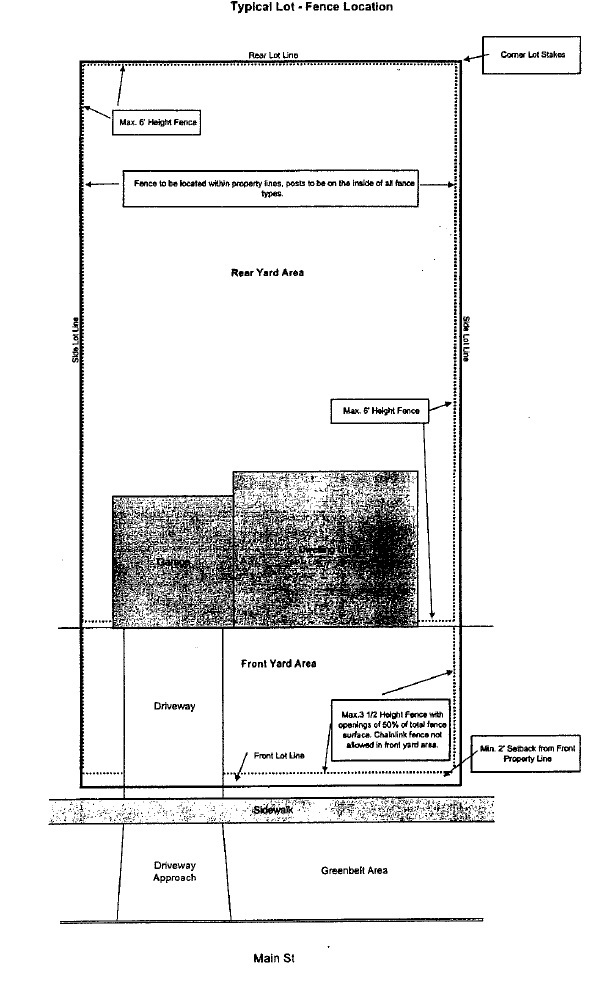
(Ord. 98-3. Passed 8-10-98; Ord. 2005-03. Passed 4-11-05; Ord. 2017-01. Passed 2-27-17.)